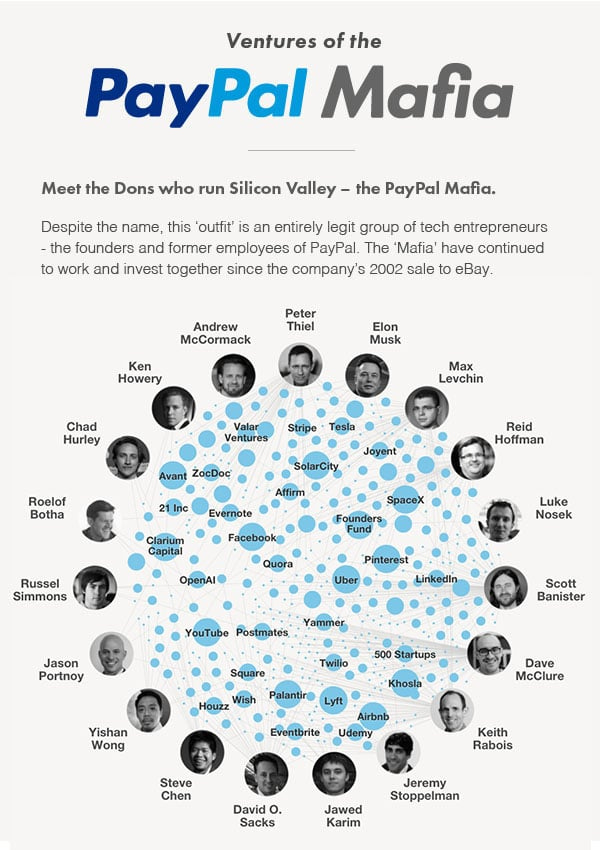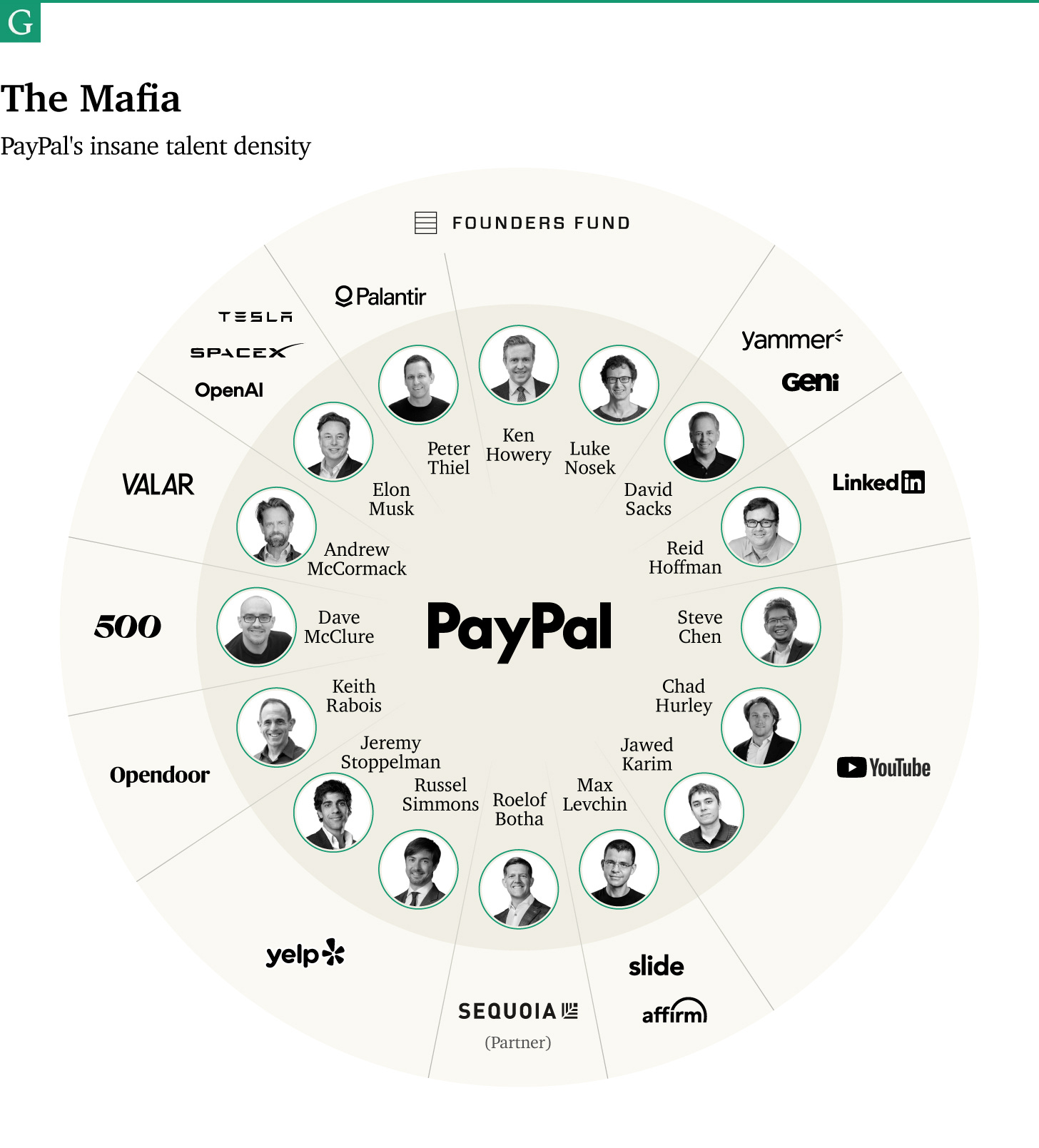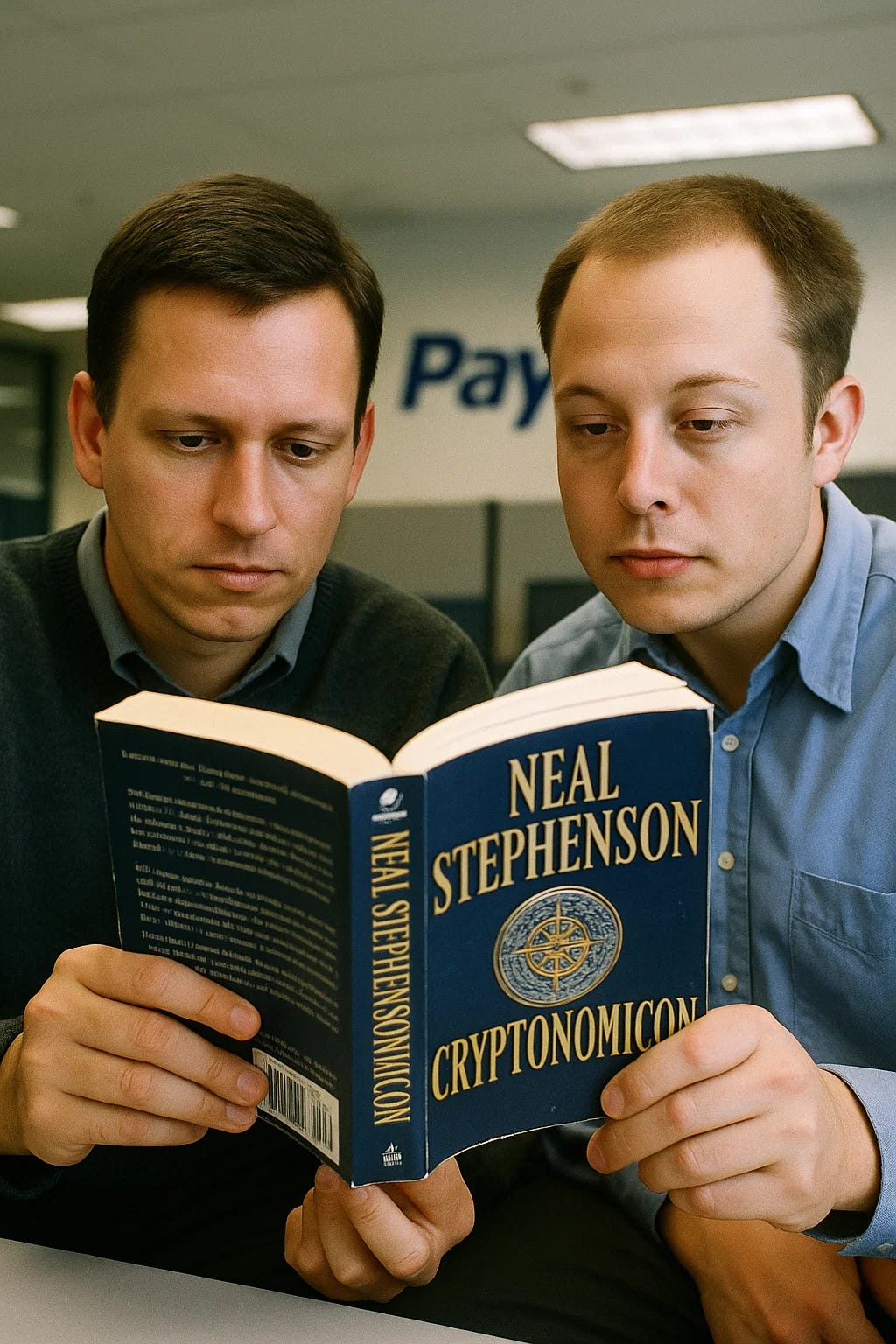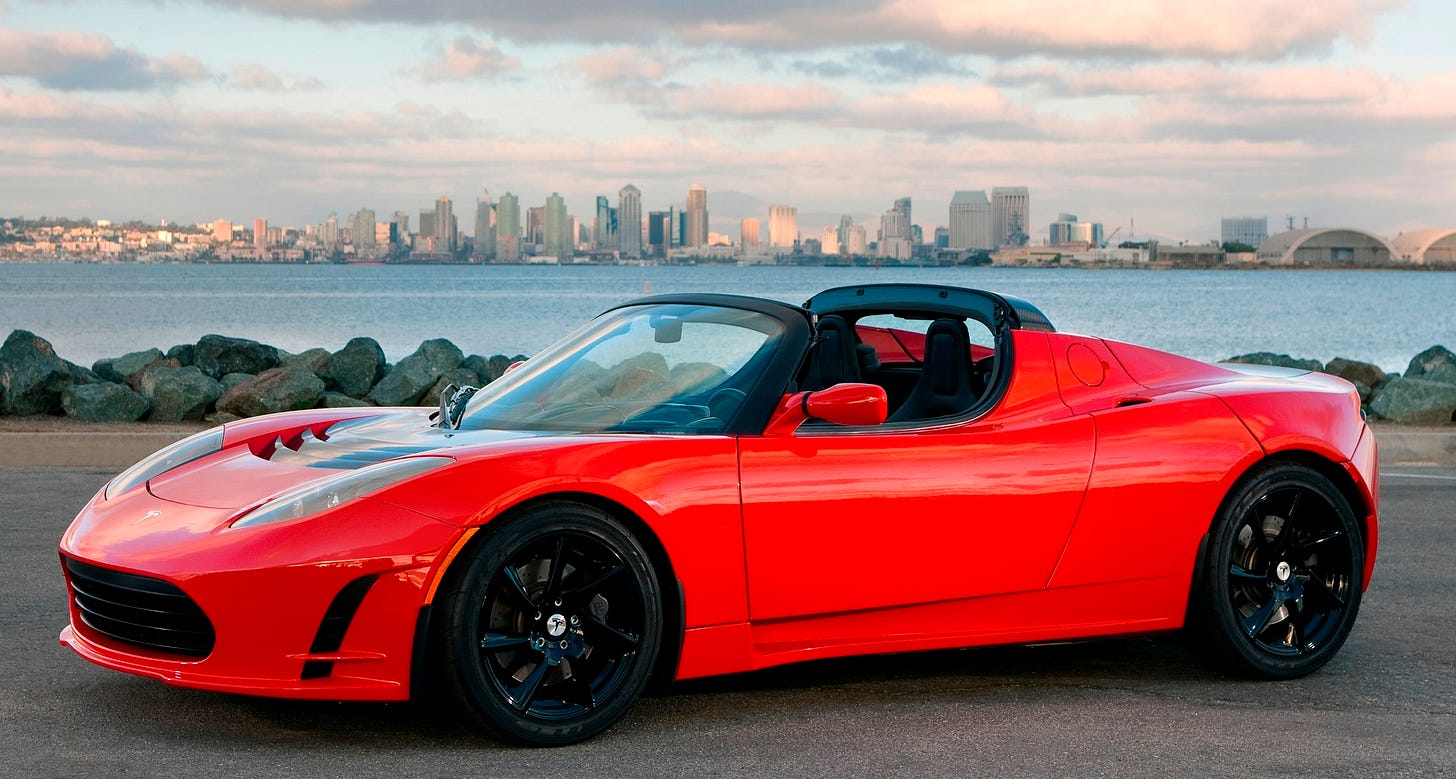Cryptonomicon and the PayPal Mafia
Intellectual fiction that inspired PayPal
I’m not much of a fiction reader, but when Peter Thiel says “Cryptonomicon was required reading [in the early PayPal days]”, I know I have to read it. So this past month, that’s what I did.
Unless you have been living under a rock, you have probably heard of the PayPal Mafia. Early PayPal employees went on to start, lead, or invest in, Facebook, SpaceX, Tesla, YouTube, LinkedIn, Palantir, Uber, Lyft, Stripe, OpenAI, Airbnb, Sequoia Capital, Founders Fund, Neuralink, Yammer, Yelp, Quora, Reddit, Tumblr, Pinterest, Evernote, and Khosla Ventures.
In other words, PayPal Mafia = Bell Labs of the business world.
Interestingly, the only mention of the connection between Cryptonomicon and the PayPal Mafia I could find was the one sentence in Zero To One -
“The early PayPal team worked well together because we were all the same kind of nerd. We all loved science fiction: Cryptonomicon was required reading, and we preferred the capitalist Star Wars to the communist Star Trek.”
I don’t know of a single interview where any of the Mafia members mention the book, and neither do ChatGPT o3 pro or Gemini 2.5 Pro. (If you do, please email me!) So when I started reading it, I felt a dopamine surge like the one you get when you find a hidden intellectual treasure trove that the internet hasn’t discovered yet.
After pounding through the ~900 pages of intellectual fiction that is Cryptonomicon, from cryptography to information theory to business strategy and beyond, the things I’ve learnt are remarkable — by far the most insights I’ve gleaned from a fiction book. So here’s an essay about my top learnings, connecting the dots with the PayPal Mafia.
I think the first page of Cryptonomicon gives a great overview of what the book is about -
“There is a remarkably close parallel between the problems of the physicist and those of the cryptographer. The system on which a message is enciphered corresponds to the laws of the universe, the intercepted messages to the evidence available, the keys for a day or a message to important constants which have to be determined. The correspondence is very close, but the subject matter of cryptography is very easily dealt with by discrete machinery, physics not so easily.” —Alan Turing
This morning [Imelda Marcos] offered the latest in a series of explanations of the billions of dollars that she and her husband, who died in 1989, are believed to have stolen during his presidency. “It so coincided that Marcos had money,” she said. “After the Bretton Woods agreement he started buying gold from Fort Knox. Three thousand tons, then 4,000 tons. I have documents for these; 7,000 tons. Marcos was so smart. He had it all. It’s funny; America didn’t understand him.”
—The New York Times, Monday, 4 March, 1996
Let’s dive in!
Making License Plates
Cryptonomicon has 3 interweaved plot lines. One is about World War II military; another is about cryptography; and the third is about a startup. The startup, called Epiphyte Corporation, is run by Avi and Randy — an excerpt about this below, followed by some dot-connecting!
“Pinoy-grams?”
“Here’s how it works. You are an Overseas Contract Worker [in the Philippines]. Before you leave home for Saudi or Singapore or Seattle or wherever, you buy or rent a little gizmo from us. It’s about the size of a paperback book and encases a thimble-sized video camera, a tiny screen, and a lot of memory chips. The components come from all over the place — they are shipped to the free port at Subic and assembled in a Nipponese plant there. So they cost next to nothing. Anyway, you take this gizmo overseas with you. Whenever you feel like communicating with the folks at home, you turn it on, aim the camera at yourself and record a little video greeting card. It all goes onto the memory chips. It’s highly compressed. Then you plug the gizmo into a phone line and let it work its magic.”
“What’s the magic? It sends the video down the phone line?”
“Right.”
“Haven’t people being messing around with video phones for a long time?”
“The difference here is our software. We don’t try to send the video in real time — that’s too expensive. We store the data at central servers, then take advantage of lulls, when traffic is low through the undersea cables, and shoot the data down those cables when time can be had cheap. Eventually the data winds up at Epiphyte’s facility in Intramuros. From there we can use wireless technology to send the data to 24 Jam stores all over Metro Manila. The store just needs a little pie-plate dish on the roof, and a decoder and a regular VCR down behind the counter. The Pinoy-gram is recorded on a regular videotape. Then, when Mom comes in to buy eggs or Dad comes in to buy cigarettes, the storekeeper says, ‘Hey, you got a Pinoy-gram today,’ and hands them the videotape. They can take it home and get the latest news from their child overseas. When they’re done, they bring the videotape back to 24 Jam for reuse.”
…
“So, let me guess,” she says, “you are the guy doing the software.”
“Yeah,” he admits, a little defensive, “but the software is the only interesting part of this whole project. All the rest is making license plates.”
That wakes her up a little. “Making license plates?”
“It’s an expression that my business partner and I use,” Randy says. “With any job, there’s some creative work that needs to be done — new technology to be developed or whatever. Everything else — ninety-nine percent of it — is making deals, raising capital, going to meetings, marketing and sales. We call that stuff making license plates.”
She nods, looking out the window. Randy is on the verge of telling her that Pinoy-grams are nothing more than a way to create cash flow, so that they can move on to part two of the business plan. He is sure that this would elevate his stature beyond that of dull software boy. But Amy puffs sharply across the top of her coffee, like blowing out a candle, and says, “Okay. Thanks…”
Now, compare this to the memo Elon Musk wrote on August 2, 2006, titled “The Secret Tesla Motors Master Plan (just between you and me)”.
As you know, the initial product of Tesla Motors is a high performance electric sports car called the Tesla Roadster. However, some readers may not be aware of the fact that our long term plan is to build a wide range of models, including affordably priced family cars. This is because the overarching purpose of Tesla Motors (and the reason I am funding the company) is to help expedite the move from a mine-and-burn hydrocarbon economy towards a solar electric economy, which I believe to be the primary, but not exclusive, sustainable solution.
Critical to making that happen is an electric car without compromises, which is why the Tesla Roadster is designed to beat a gasoline sports car like a Porsche or Ferrari in a head to head showdown. Then, over and above that fact, it has twice the energy efficiency of a Prius. Even so, some may question whether this actually does any good for the world. Are we really in need of another high performance sports car? Will it actually make a difference to global carbon emissions?
Well, the answers are no and not much. However, that misses the point, unless you understand the secret master plan alluded to above. Almost any new technology initially has high unit cost before it can be optimized and this is no less true for electric cars. The strategy of Tesla is to enter at the high end of the market, where customers are prepared to pay a premium, and then drive down market as fast as possible to higher unit volume and lower prices with each successive model.
Without giving away too much, I can say that the second model will be a sporty four door family car at roughly half the $89k price point of the Tesla Roadster and the third model will be even more affordable. In keeping with a fast growing technology company, all free cash flow is plowed back into R&D to drive down the costs and bring the follow on products to market as fast as possible. When someone buys the Tesla Roadster sports car, they are actually helping pay for development of the low cost family car.
The way I think of this is, you start with a broad worldview and mission for what you want to accomplish (e.g., making humanity a space-faring civilisation), and then construct a business model around that vision. Who would’ve thought space exploration could be a business? Yet, SpaceX did it.
Start with a mission —> turn it into a business model —> use the cash flows to expand in the direction of your larger mission —> repeat forever.
Here’s what
writes about how Astro Mechanica is applying this idea.When you want to fly somewhere – a little hop from SF to LA or a globe-spanning trip from New York to Tokyo – you book it directly with Astro Mechanica. You get there three times faster on planes designed and built by Astro Mechanica, powered by Astro Mechanica engines.
That’s the big goal, the one that changes the world by shrinking it.
But building planes that will fly passengers is a very expensive endeavor, thanks in part to the years and many test flights it takes to get a plane flight certified. A new Gulfstream might take 3 years and $5-7 billion dollars to get to the point at which it can start carrying passengers.
So you can’t start there. It would require so much venture capital that the founder wouldn’t end up owning anything at the end, even assuming he’s able to raise all the money. Plus, you’d want to run tests on something that you don’t mind blowing up.
So: to build the airline of the 21st Century, begin by launching rockets. Duh.
Space launch is the Roadster in Astro’s Tesla strategy: start at the highest end of the market and move cheaper and more mass market over time. From space launch to private planes (Model S), from private planes to commercial airliners (Model 3), building the airplane gigafactory along the way, until it’s churning out planes of all sizes cheaply and reliably.
And the below excerpt from Cryptonomicon reminded me of SpaceX’s reusable rockets.
If it will take ten years to make the machine with available technology, and only five years to make it with a new technology, and it will only take two years to invent the new technology, then you can do it in seven years by inventing the new technology first!
Philosophical Ways of Looking At Things
In the chapter titled Cycles, mathematicians Lawrence Waterhouse and Alan Turing are discussing an analogy between Turing’s bicycle and the German Enigma machine.
Waterhouse is thinking about cycles within cycles. He’s already made up his mind that human society is one of these cycles-within-cycles things* and now he’s trying to figure out whether it is like Turing’s bicycle (works fine for a while, then suddenly the chain falls off, hence the occasional world war) or like an Enigma machine (grinds away incomprehensibly for a long time, then suddenly the wheels line up like a slot machine and everything is made plain in some sort of global epiphany or, if you prefer, apocalypse) or just like a rotary airplane engine (runs and runs and runs; nothing special happens; it just makes a lot of noise).
*He has no hard data to back this up; it just seems like a cool idea.
Compare this to Peter Thiel’s standard question about college.
Is college a consumption good, like a four-year party? Is it an investment in the future? Is it an insurance policy? Or is it a tournament like the exclusive Studio 54 nightclub?
Contrarian Truths
To the savvy reader, Cryptonomicon is chockablock full of Thiel-esque contrarian truths and secrets. A couple excerpts below.
Dr. G. E. B. Kivistik had a few things to say about the Information Superhighway. He was a fiftyish Yale professor who had just flown in from someplace that had sounded really cool and impressive when he had gone out of his way to mention it several times. His name was Finnish, but he was British as only a non-British Anglophile could be. Ostensibly he was here to attend War as Text. Really he was there to recruit Charlene…
Another example, this time in the context of WW II cryptography, and its information theoretic implications.
“If what you are saying is true,” Lawrence says, “the jig must be up already. Rudy [the German cryptographer] must have figured out that we’ve broken their codes.”
“An informal system has been in place, which might be thought of as a precursor to Detachment 2701, or 2702 or whatever we are calling it,” Alan says. “When we want to sink a convoy, we send out an observation plane first. It is ostensibly an observation plane. Of course, to observe is not its real duty — we already know exactly where the convoy is. Its real duty is to be observed — that is, to fly close enough to the convoy that it will be noticed by the lookouts on the ships. The ships will then send out a radio message to the effect that they have been sighted by an Allied observation plane. Then, when we come round and sink them, the Germans will not find it suspicious — at least, not quite so monstrously suspicious that we knew exactly where to go. (emphasis added)
And one more.
The United States Military (Waterhouse has decided) is first and foremost an unfathomable network of typists and file clerks, secondarily a stupendous mechanism for moving stuff from one part of the world to another, and last and least a fighting organization.
Digital Currency
Gold-backed, cryptographically-enabled digital currency is perhaps the crux of the book. The parallels to Confinity — Peter Thiel and Max Levchin’s company that merged with X.com to become PayPal — are compelling.
Excerpt from the book -
“Doug. You can do this,” Randy says. “You get the gold. You put it on a boat. My friends here can explain the rest.” Randy fits the laptop’s plastic case back together and begins maneuvering the little screws back into their recesses.
Cantrell says, “You bring the boat here.”
Tom continues, “To that beach, right down the hill. I’ll be waiting for you with the Humvee.”
“And you and Tom can drive it downtown and deposit that bullion in the vaults of the Central Bank of Kinakuta.” Cantrell concludes.
Someone has finally said something that actually knocked Doug Shaftoe off balance. “And get what in return?” he asks suspiciously.
“Electronic cash from the Crypt. Anonymous. Untraceable. And untaxable.”
Compare this to what Jimmy Soni writes in The Founders, a book about the PayPal founding story -
In February 1999, Levchin attended the International Financial Cryptography Association conference. Hosted in Anguilla, a sliver of a Caribbean island, the annual gathering drew the leading players in academic cryptography and digital currencies. (To this day, Thiel, who attended the 2000 conference, harbors a theory that Satoshi Nakamoto—the mysterious founder of the cryptocurrency Bitcoin—was among the attendees.)
…
When Confinity had originally launched, it flirted with starting a universal digital currency free from government shackles.
…
In its original pitch documents, Confinity cast Mobile Wallet as a means of liberating the masses from currency-manipulating governments and reserve banks … Even the team’s casual internal parlance—“The World Domination Index,” for example, or the “New World Currency”—spoke to the aim of making PayPal a border-busting universal payments system.
X.com, too, had world conquest baked into its early DNA. One day, Musk hoped X.com would serve as the “global center for all money” and store the world’s dollars, deutschmarks (soon to be euros), and yen in one place. To Musk, this trajectory wasn’t revolutionary—it was obvious. Musk thought about currencies “from an information theory standpoint,” a reference to the field founded by Dr. Claude Shannon in 1948. “Money is an information system,” he explained. “Most people think money has power in and of itself. But actually, it’s really just an information system, so that we don’t have to engage in barter and that we can time-shift value in the form of loans and equity and stuff like that.”
Mathematical Skeleton
Two of my favourite excerpts from the book below.
The basic problem for Lawrence was that he was lazy. He had figured out that everything was much simpler if, like Superman with his X-ray vision, you just stared through the cosmetic distractions and saw the underlying mathematical skeleton. Once you found the math in a thing, you knew everything about it, and you could manipulate it to your heart's content with nothing more than a pencil and a napkin. He saw it in the curve of the silver bars on his glockenspiel, saw it in the catenary arch of a bridge and in the capacitor-studded drum of Atanasoff and Berry’s computing machine. Actually pounding on the glockenspiel, riveting the bridge together, or trying to figure out why the computing machine wasn't working were not as interesting to him.
…
As it happens, Alan has become fascinated by the incarnations of pure ideas in the physical world. The underlying math of the universe is like the light streaming in through the window. Alan is not satisfied with merely knowing that it streams in. He blows smoke into the air to make the light visible. He sits in meadows gazing at pine cones and flowers, tracing the mathematical patterns in their structure, and he dreams about electron winds blowing over the glowing filaments and screens of radio tubes, and, in their surges and eddies, capturing something of what is going on in his own brain. Turing is neither a mortal nor a god. He is Antaeus. That he bridges the mathematical and physical worlds is his strength and his weakness.
Investor Meetings
I found it fascinating how Avi prepares for an investor meeting.
Of the half-dozen important people in the room, three are middle-aged Filipino men. One of these is a high-ranking official in the PTA. The second is the president of an upstart telecommunications company called FiliTel, which is trying to compete against the traditional monopoly. The third is the vice president of a company called 24 Jam that runs about half of the convenience stores in the Philippines, as well as quite a few in Malaysia. Randy has trouble telling these men apart, but by watching them converse with Avi, and by using inductive logic, he is soon able to match business card with face.
The other three are easy: two Americans and one Nipponese, and one of the Americans is a woman … Her card identifies her as Mary Ann Carson, and claims that she is a V.P. with AVCLA, Asia Venture Capital Los Angeles, which Randy knows dimly as a Los Angeles-based firm that invests in Rapidly Developing Asian Economies. The American man … represents the Subic Bay Free Port. The Nipponese man is the executive vice president of a subsidiary of a ridiculously colossal consumer-electronics company.
…
Avi wastes little time in starting the videotape, which at the moment represents about seventy-five percent of Epiphyte Corp.’s assets. Avi had it produced by a hot multimedia startup in San Francisco, and the contract to produce it accounted for one hundred percent of the startup’s revenue this year…
It starts with footage — pilfered from a forgotten made-for-TV movie — of a Spanish galleon making headway through heavy seas. Superimpose title: SOUTH CHINA SEA—A.D. 1699. The soundtrack has been beefed up and Dolbyized from its original monaural version. It is quite impressive. (“Half of the investors in AVCLA are into yachting,” Avi explained.)
…
Cut to a stone tower on the crown of a green tropical island, where a lookout is sighting the (digitally inserted) galleon on the horizon. The lookout cups his hands around his mouth and bellows, in Spanish, “It is the galleon! Light the signal fire!” (“The family of the guy who runs the PTA is really into local history,” Avi said, “they run the Museum of the Philippines.”)
…
Cut to a series of shots of Manila townsfolk rushing to the seawall to adore the signal fire, including an Augustinian monk who clasps his rosary-strewn hands and bursts into clerical Latin on the spot (“the family that runs FiliTel endowed a chapel at Manila Cathedral”) as well as a clean-cut family of Chinese merchants unloading bales of silk from a junk (“24 Jam, the convenience store chain, is run by Chinese mestizos”).
A voiceover begins, deep and authoritative, English with a Filipino accent (“The actor is the brother of the godfather of the grandson of the man who runs the PTA”). Subtitles appear on the bottom of the screen in Tagalog (“the PTA people have a heavy political commitment to the native language”).
It reminds me of this extract from Walter Isaacson’s biography of Elon Musk.
For their first meeting with potential investors, [Kimbal and Elon] had to take a bus Sand Hill Road because the car their dad had given them broke down. But after word spread about the company, the VCs were asking to come to them. They bought a big frame for a computer rack and put one of their small computers inside, so that visitors would think they had a giant server. They named it “The Machine That Goes Ping,” after a Monty Python sketch. “Every time investors would come in, we showed them the tower,” Kimbal says, “and we would laugh because it made them think we were doing hardcore stuff.”
Haiku
Cryptonomicon starts with a haiku: a three-line poem with 5 syllables in the first, 7 in the second, then 5 again in the third. So, in that spirit, here’s a haiku I made up, to wrap up this essay.
PayPal Mafia,
Ideas that change the world,
I want to find mine.
Feedback and reading recommendations are invited at malhar.manek@gmail.com









yes! I think all the time about how science fiction interrelates with the actual tech industry - I’m planning to write quite a bit about this soon - and here’s one short thing I wrote recently: https://lydialaurenson.substack.com/p/my-top-science-fiction-and-fantasy
Such a unique topic and an even more insightful articulation!